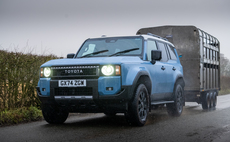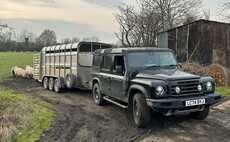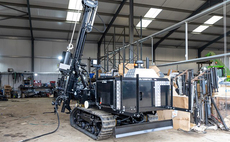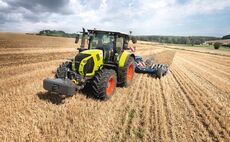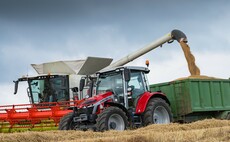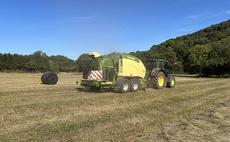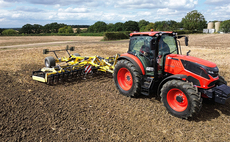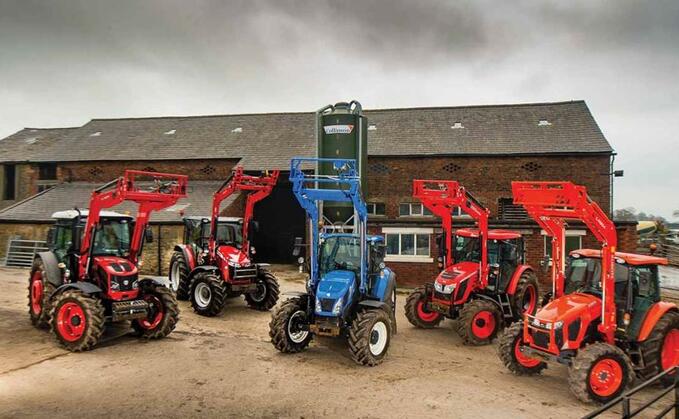
With the emphasis on mechanically simple, straightforward, 110hp loader tractors, this group comparison test looks at some of the latest machines on the market which are aimed squarely at the livestock sector.
James Rickard and Geoff Ashcroft report. Pictures by Marcello Garbagnoli.
Tractor buyers face some difficult choices when shortlisting loader tractors around the 100-110hp mark.
Do you choose premium brands or opt for lesser-known kit in the hope robust engineering and dealer back-up can pick up the slack?
We have shortlisted five key players in this competitive sector to provide a flavour of what you might expect to find for your money. And it starts with a no-frills, fresh-face in the market from ArmaTrac, plus industry heavyweights from Massey Ferguson and New Holland.
Also in the mix are well-respected livestock favourites from Kubota and Zetor.
Suitability
With the livestock sector clearly in mind, our key objectives are to assess each tractors' suitability as a yardie, but also to weigh up their capabilities for working with implements.
So a mix of loader and pto-powered work on a busy dairy and beef farm ticks the boxes for this round-up.
Our tractors were deliberately specified as ‘simple' machines, with predominantly mechanical controls and an abundance of levers chosen over electronic complexity. Power requirement was about 110hp.
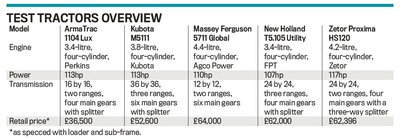
CAB & CONTROLS: ARMATRAC 1104 LUX
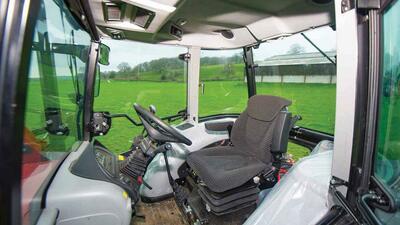
WIDE but shallow steps provide good access to the 1104's spacious cab. It could, however, do with a third grab handle in the cab, rather than relying on the steering wheel.
Layout is best described as functional and robust, the right-hand console in particular. It has everything you need but could do with being a bit higher for more convenience. Likewise, the pto speed selection levers are positioned under the front of the seat, eating into foot space. These would be better on one side of the cab.
An easy to use blister button control panel for the work lights and wipers is awkwardly placed and its position would be best swapped with the linkage controls.
The latter is Bosch's well known, tried and tested system.
Awkward
Floor-mounted gear sticks fall relatively well to hand and it is the only tractor in this group to use a right-hand shuttle. This is awkward when using the loader, as your right hand has to come off the joystick to use the shuttle, and vice-versa.
The rotary hand throttle is a novelty, no worse or better than a conventional hand throttle, and it will certainly give you something to talk about down the pub. As will its racing start procedure which requires the clutch pedal to be held down, ignition key turning followed by a press of a button to get it going. Why not just press and hold the clutch?
Steering wheel adjustment is tilt only, but it is positioned high enough in the cab to be within comfortable reach. Climate control is standard. All vents are located in the roof, with two at the rear used to good effect to clear windows or keep your back cool.
Currently not an option, the 1104 really needs a roof window for loader work. At present, a lot of neck straining is required.
Otherwise, visibility is not too bad from its lofty driving position.
The biggest downside of the ArmaTrac's cab is the noise; recording 87dBA on the road. This really needs reducing for long working days.
7/10
CAB & CONTROLS: KUBOTA M5111
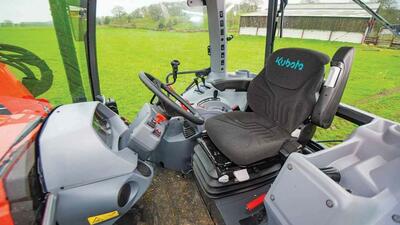
BIGGER and better than its predecessor, the M5's cab stacks up well against its competitors in this test.
Unhindered access, wide opening doors and plenty of grab rails make ingress and egress fuss free.
Although our test tractor was not fitted with the optional passenger seat, which could affect this.
Solid grey plastics give a sense of rugged build quality, and cab layout is straightforward. Control labelling is clear too, making it obvious to understand what everything does.
Generous
Similarly, its generous dashboard could not be clearer. Huge dials and chunky LCD graphics provide easy information at a glance.
Most controls fall easily to hand, save for the range lever which is a bit of a stretch when in high, and its loader joystick does serve up a fair amount of ‘play'. Pedal position is well thought out and the floor space provides plenty of room for big boots.
Considering the M5's compact nature, there is plenty of headroom too.
Ventilation louvres are a bit lacking, with only four dotted around the centre console, all at knee height, and nothing in the roof or at the rear of the cab.
Clearing steamed up windows could prove taxing. As for driving position, you can get relatively comfy, although this is spoilt slightly by the lack of steering wheel reach adjustment. However, a middle pedal does offer quick steering wheel tilt adjustment.
Bearing in mind the amount of exhaust ‘clean-up' equipment crammed under the bonnet, sight lines around the front are good compared to the rest.
In addition, curved rear quarter windows and a generously-sized roof window with skinny cross member offer good all-round views - certainly one of the best in this test.
9/10
CAB & CONTROLS: MASSEY FERGUSON 5711 GLOBAL
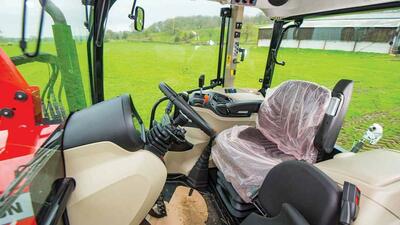
FILLED with light coloured materials, the 5711's cab feels a wide and airy place to sit.
It is well-finished and the sixpost cab design sees two opening rear windows - ideal for fresh air. Up-front is a smart looking, compact dash.
As such, it provides good forward views over and around the bonnet, though its compact nature means there is less space for information to be shown. And a small LCD screen used for pto and forward speeds highlights this shortcoming.
Conversely, the uncluttered right-hand console is spot-on, with spool levers and electronic linkage control at your fingertips.
Frustrating
Less convenient is the floormounted gearstick, which could do with being a tad taller for easier reach and to avoid your knee accidentally pushing the integrated declutch button.
This can be frustrating and confusing. Neatly finding a home on the right-hand B-post are secondary set-up controls for linkage and pto speed selection, as well as the ignition key.
Loader joystick is one of the best placed. You can actually rest your elbow on the armrest while using it. And unlike many others in the test, the 5711 gets an easy steering wheel adjustment system, with both reach and rake taken care of.
Floor area is uncluttered, with loads of foot space. Yet entry/exit path is comparatively narrow and your knee is likely to hit the passenger's seatbelt socket on the way by.
Unlike its higher-spec stablemate, the 5700 S, the 5700 Global does not get a sloping bonnet, but sightlines to the loader are still good despite this.
MF offers its Visio roof as an option and, having experienced this tractor without it, this is a musthave
option for loader work.
The only hindrance to sight lines can be found at the rear corners, caused by the large rear mudguards.
9/10
CAB & CONTROLS: NEW HOLLAND T5.105 UTILITY
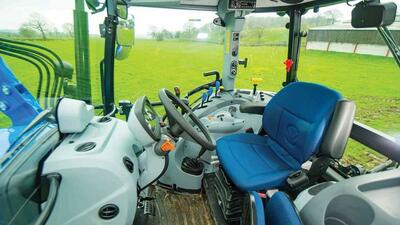
ITALIAN flair is the order of the day when it comes to the T5's design. While controls such as spool levers, throttle and linkage are all placed in convenient positions, the main gearstick can be a stretch, particularly in third, and also very close to the spool levers when in fourth.
Additionally, the range change lever lacks space for your knuckles, which can easily get bashed on the side console.
Granted, space is at a premium on these ‘small' tractors, but some of the switchgear locations are questionable in this T5, with switches scattered between the dash, main console and two B-posts.
Suitable
Our biggest gripe is the positioning of the 4WD and differential lock switches on the right-hand console, which could easily be moved to a more suitable position where you need them the most - under your fingertips near the throttle and gearsticks.
Similarly, why not have the shuttle aggression rocker switch near the shuttle, instead of having to go hunting for it. It seems sometimes style wins over practicality.
The T5's shuttle lever is up for debate too. As it returns to centre every time it is used, there is no way to tell without looking at the dash which direction has been selected. A button on the end of the lever is then used to select neutral.
Also, when the steering wheel's telescoping element is pulled towards you, the column-mounted controls do not travel with the wheel, meaning the shuttle can easily become out of reach of your fingers.
And, as spotted the last time we tested a T5, the centre console's cowling does limit the space around the pedals for your feet.
But equipped with an almost fullwidth transparent roof panel and a narrow cross member, the New Holland is easily the best in this group for upwards visibility. The roof panel opens for a bit of fresh air, though a fiddly two-piece sun blind really could do with a rethink.
9/10
CAB & CONTROLS: ZETOR PROXIMA HS120
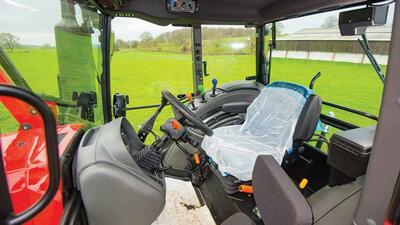
FEATURING soft-touch, dark grey materials, the Proxima's cab is one of the most spacious and well finished cabs in this test.
Its new colour LED dash gives a sense of modernity and offers a wealth of information, easily scrolled through. Overall cab layout is well thought out, and chunky levers for the spools, linkage and gearstick will appeal greatly to many operators, including us.
In fact, its gearstick is one of the best positioned in this test. However, we would suggest Zetor places brushes in the spool lever slots to prevent dirt and dust ingress into the side console.
Apart from some unclear labelling for pto levers, the rest of the controls are obvious. Scattered under and around the steering column are switches for the Proxima's 4WD, diff-lock and transmission auto-shift.
The lefthand shuttle is conveniently placed at your fingertips, too. Access is decent, but the passenger seat gets cosy when getting in the cab.
The Proxima gets both reach and rake steering adjustment, allowing for a comfy driving position. But the screw adjustment system for both elements is awkward and could do with simplifying.
Position
However, once in position, you can leave the column in place as there is enough room to get in and out, occasionally snagging the indicator stalk.
A transparent roof hatch is standard, but as an aid to viewing a raised loader it seems a token gesture, particularly when compared to the great views afforded by New Holland and Kubota's transparent roof windows.
The Zetor's bulbous bonnet also results in a good deal of leaning to one side, to see when hitching up loader attachments. And its high cab sides do give a sense you are sat low in the cab.
All ventilation is in the roof, providing flexible airflow around the cab.
9/10
top

bottom
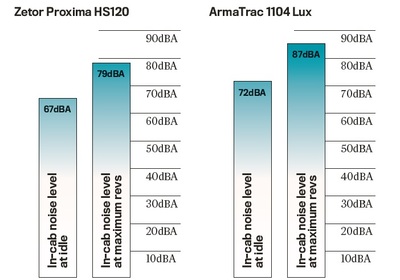
ENGINE & TRANSMISSION: ARMATRAC 1104 LUX
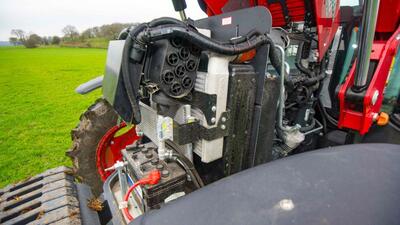
THE ArmaTrac offers 16 forward and 16 reverse gears, accessed by four on the main lever, with a highlow range and a split.
While it might be the pinnacle of mechanical simplicity, the 1104 needs you to reach for the clutch pedal to change direction.
Clutch
This might put you in control of shuttle aggression, but its weight makes it harder to feather and easy to drop. This also puts you in direct control of clutch wear too, as this one uses a 12-inch cerametallic dry clutch.
Gear lever movement is considerable, and you will need to factor in some deft handiwork to combine loader and shuttle functionality at the same time. It is one you just cannot hustle.
Up front, the Perkins four-pot turbo is a gutsy and solid performer. It is vocal too, once you have mastered the engine start procedure and swung the engine into life. It remains an EU Stage 3b compliant unit, though, so does not need diesel exhaust fluid.
Stopping power is not so confidence-inspiring either, with the brake pedals requiring a good ‘stamp' to make them really work. Brakes are either on or off.
While this tractor is perhaps the least mentally demanding to operate, it is the most physically demanding of this bunch.
6/10
ENGINE & TRANSMISSION: KUBOTA M5111
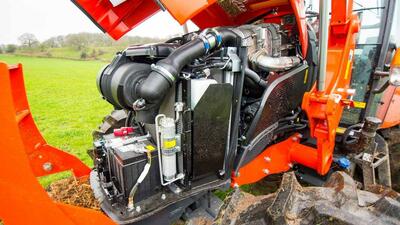
PEAK power and torque levels are now achieved lower down the rev range on Kubota's new M5 tractors, which showed during a variety of applications, particularly on the diet feeder and when diving into muck heaps with the loader.
The 113hp engine gets an engine speed memory function, but is overly complex to set-up, especially compared to MF's simple ‘press and hold' version.
Gear choice is plentiful, but main gear changes can be notchy and gear gates are quite close together, which can result in the wrong gear being selected.
There are also no definite detents on the range change lever, which again can lead to a bit of confusion. You also have to be stationary when you change range, so make sure you are in the right range before you hit the hill.
Clutch pedal is light enough with plenty of feel. Compared to the MF, the de-clutch button on the gearstick is less effective, with quite a delayed response.
Shuttle aggression is fixed, with no operator adjustment, but it is well set-up - you can sometimes have too many settings on a simple tractor.
The M5 gets a conventional handbrake and a transmission handbrake, both of which need applying before you leave the seat as the tractor will give you a savage audio warning.
But it does nothing to prevent you from applying the transmission park brake too soon.
8/10
ENGINE & TRANSMISSION: MASSEY FERGUSON 5711 GLOBAL
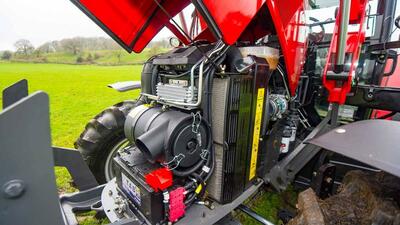
IN the 5711's case, it essentially uses what was the old 5600's transaxle, married to the firm's new 12 by 12 Global Series mechanical transmission, with power coming from a 4.4-litre Agco motor.
Compared to the others, the MF is lacking in gears, with only 12 to choose from. It could just do with
a splitter, but there is now a 16-speed semi-powershift version available.
Ratios are well spaced, gear changes are slick using the six-speed gate and there is no confusion where the gears are. The de-clutch button works well too, and the tractor is very drivable using this.
It is also only one of two tractors in the test to have an engine memory function. But unlike the Kubota's, this one is simple to use.
The electronic throttle and memory functions remain stored until you change them - they will not disappear when the ignition is turned off.
Such simplicity makes this one a joy to use. Up front, MF has avoided EGR and a DPF with this 4.4-litre engine to reach EU Stage 4 emissions. An 18-litre DEF tank complements its 153-litre fuel tank and a DOC, to avoid time-wasting and high-heat cycles from a DPF regeneration.
Smooth and relatively quiet, the Agco power unit withholds the firm's tradition of delivering strong torque and capable grunt, without having to chase high rpm in and around the buildings.
7/10
ENGINE & TRANSMISSION: NEW HOLLAND T5.105
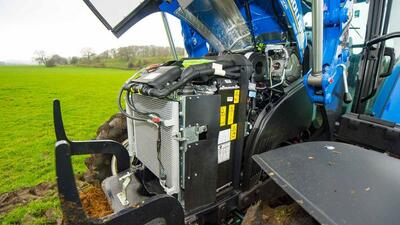
ONE of only two tractors in this test, the other being MF, to offer adjustable shuttle aggression. Ideal for tailoring to particular jobs or driving style.
You do get a ridiculously light clutch pedal feel, and awkwardly placed and spaced gear levers give access to the 24 by 24 transmission.
This comprises three ranges, with four gears in each range. The main gear lever carries an electrically-operated gear split, and a transmission disconnect button, which are easy to differentiate.
The latter was lazy to re-engage when you let go, and could have needed recalibrating.
Inconvenience
However, the splitter is a good feature, giving the transmission added flexibility for both yard and
field work.
Swapping from range II to III can be awkward, and you will soon resort to leaving it in III. Handy then, that the FPT engine has enough grunt to mask the inconvenience of changing ranges.
The T5's 3.4-litre FPT four-pot engine is one of the smallest capacity here, and matches the ArmaTrac's 3.4-litre Perkins lump for size.
But that is where the differences end.
The New Holland is smoother, quieter and feels much more gutsy, too. And it should, with 107hp supported by 444Nm of torque - the latter delivered at just 1,500rpm.
8/10
ENGINE & TRANSMISSION: ZETOR PROXIMA HS120
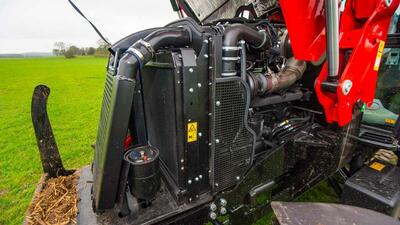
THE most powerful of the group, Zetor's Proxima HS120 uses a long stroke 4.2-litre engine which provides a stonking 507Nm of torque. Meeting EU Stage 4 emissions with SCR, DPF and EGR, the engine gives 117hp.
Unusually for such a cleanburning engine, fuelling is carried out using an inline injection pump, but with electronic control.
Power runs through a 24 by 24 transmission which uses four gears, in two ranges. Each of the four gears also has a three-speed powersplit with buttons on the side of the gear lever. In a nod to loader work, the ratios offer a slightly faster reverse speed through the electro-hydraulic shuttle, than the forward speed.
Automated
Of all the tractors tested, the Proxima was the only one to feature any kind of automated transmission. This came in the form of automated shifting of the three splits, and it works really well.
Auto shifting can be turned on or off with a button on the dash, though it only operates in high range, so the system is configured towards on-road and transport use.
That said, it will speed match too, and using the declutch button on the rear of the gearstick and changing up or down, will reward the thoughtful operator.
Shift points are memorised too, based on the last known gear change when used in non-auto mode.
True four-wheel braking uses internal disc brakes in the Carraro front axle, offering powerful braking with very little pedal effort.
9/10
stats
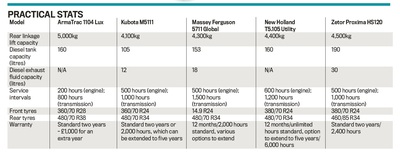
PRACTICALITIES & MAINTENANCE: ARMATRAC 1104 LUX
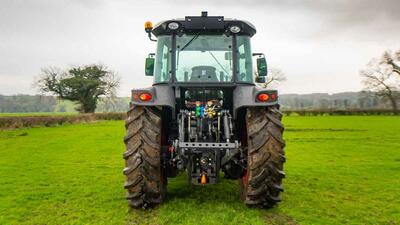
WITH only 200 hours between service intervals, the ArmaTrac will rarely be out of the workshop.
All radiators are bolted in place too, which leaves little space for cleaning and access.
A single piece bonnet provides easy access to the engine, though the diesel filter is so tightly packed into the back, you will struggle to swap it. Engine oil dipstick access is tricky too, with the loader subframe in place.
At the rear, four spools are fitted as standard. But close positioning means there is little room for your hands to get around pipes when multiple spools are occupied.
With no push out hitch option, the ArmaTrac's pickup hitch relies on the lower rear window and a mesh grill in the pto guard so you can eyeball through. It is less than ideal.
This is exacerbated by the positioning of the hitch which is slung far under the tractor. This also means a tight turning circle cannot be achieved with trailed equipment, to such an extent that the ArmaTrac could not handle the diet feeder around our test yard - it just lacked manoeuvrability.
However, the 1104 Lux does get a generous 5,000kg rear linkage lift capacity - the best in this test - which should prove useful for field applications.
6/10
PRACTICALITIES & MAINTENANCE: KUBOTA M5111
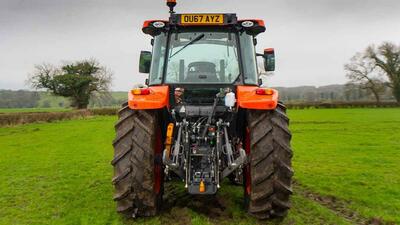
APART from two bolt-on side panels, most of the M5's bonnet is a single piece. This allows good access to the engine, and no panels need to be removed to get at the dipstick.
The engine oil filler neck could do with being longer, though, especially when fitted with a loader.
Slide-out radiator cores and a forward-positioned air cleaner complete the tractor's good access characteristics.
Spools are conveniently biased to the left, and it gets useful drawbar storage too. Its pto is retained by a simple circlip, which is just as well as this is the only way to switch between the pto's 540 and 1,000rpm speeds.
Less convenient is the pick-up hitch release lever located behind the seat, towards the middle of the cab. It would be better if it were closer to the right-hand side of the cab.
Valve
When not in use, there is no storage for the pick-up hitch's hydraulic pipes - a diverter valve would be the ideal solution here.
Secured by two large pins, the Kubota's loader is the most pleasing in this test to get on and off.
However, loader securing pins are a loose fit, which could prompt excessive wear rates compared to a snug fit. The loader also lacks a storage solution for its multi-coupler.
9/10
PRACTICALITIES & MAINTENANCE: MASSEY FERGUSON 5711 GLOBAL
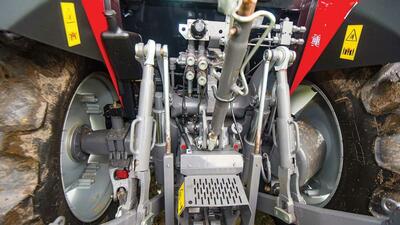
UNLIKE the likes of the Zetor and ArmaTrac, which use derivatives of older Alo loader designs, the MF gets Alo's latest X Series loader design, branded up in MF colours.
The 956X is the biggest loader in the range and features boom suspension and a slim-line mechanical parallel linkage. The latter allows good views over the tops of the loader arms, better than the bulkier linkage as used on the ArmaTrac and Zetor versions.
It is the easiest of the group to swap attachments, with a clean line of sight to the headstock.
A one-piece bonnet provides good access to the engine bay, with both battery and air cleaner positioned at the front. A retaining strap can be released to lift the bonnet higher - but the cooling pack is fixed, with a removable fly screen to help cleaning.
Accessible
Engine oil dipstick is easily accessible, and a sight glass at the rear offers a quick glance at the transmission oil level.
Up to three mechanical spools at the rear can be specified, all fixed flow, and a diverter valve that can be reached through the rear window, is a very handy feature for the pickup hitch - it saves swapping pipes.
8/10
PRACTICALITIES & MAINTENANCE: NEW HOLLAND T5.105 UTILITY
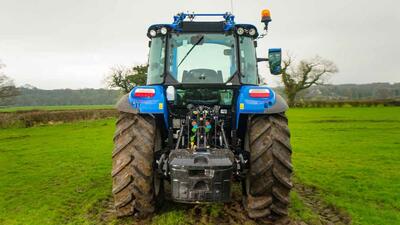
A COMBINATION of swing out and slide out elements make the T5's radiator access one of the best in the test. The engine oil dipstick can be a little awkward to access due to the loader brackets, though.
Daily checks are easy to make, and a rear axle sight glass adds to the convenience.

















